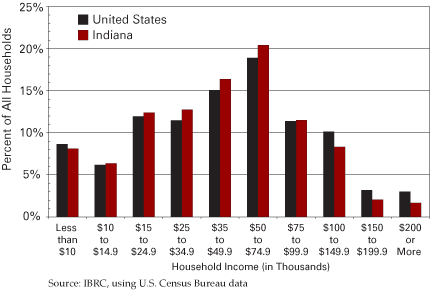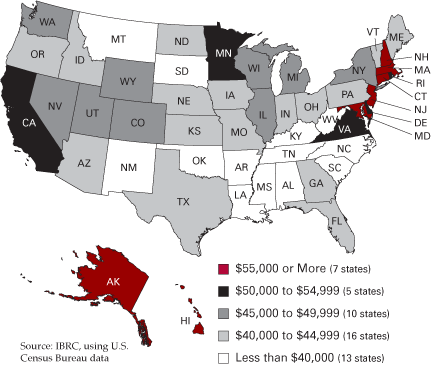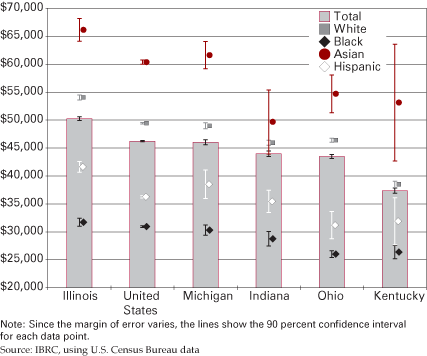Household Income Varies by Region and Race
Geodemographic Analyst , Indiana Business Research Center, Kelley School of Business, Indiana University
Indiana’s median household income trailed the United States by about $2,250, according to the 2005 American Community Survey (ACS) from the U.S. Census Bureau. The median household income for Hoosiers was $43,993 for the 12-month reference period. Meanwhile, the U.S. median household income came in at $46,242 (which means that half of the incomes were above that mark, and half were below it).
Nearly 498,700 Indiana households had incomes between $50,000 and $74,999, accounting for 20 percent of all households (see Figure 1). The fewest households in both the state and the nation were found in the top income category; less than 40,800 Hoosier households (and less than 3.4 million U.S. households) earned $200,000 or more.
Figure 1
Household Income in Indiana and the United States, 2005

With the exception of Illinois, all of Indiana’s neighboring states fall below the U.S. median (though Michigan’s number is within the margin of error). As seen in Figure 2, the lowest median household incomes are generally found in the South and Midwest. At $32,938, Mississippi residents have the lowest median nationwide, while New Jersey has the highest at $61,672.
Figure 2
Median Household Income by State, 2005

Differences by Race
In the Midwest, does one’s race and ethnicity have a bearing on median household income? (1) Indeed, for Indiana, its neighbors and the nation as a whole, Asian households have the highest median incomes, followed by whites, Hispanics and blacks (see Figure 3).
Figure 3
Midwest Household Income by Race, 2005

In Indiana, the median household income for white households is $45,943 but just $28,760 for black households—a gap of nearly $17,200. Hispanic households fall in the middle at $35,449. Asian households exceed all others at $49,681. However, since there are fewer Asian households to sample, the margin of error for that racial group is quite large.
Local Areas
ACS data are also available for areas with 65,000 people or more, which includes twenty-four Indiana counties and eight Hoosier cities.
Hamilton County’s median household income is almost $35,000 higher than the Indiana average. At $78,932, it ranks seventh nationwide among counties with less than 250,000 people. The next highest median incomes in Indiana are also found in the Indianapolis suburbs: Hendricks County has a median of $57,538, followed by Johnson County at $56,251.
Meanwhile, five of the counties for which data are available have median household incomes below $35,000: Vigo ($34,862), Wayne ($34,384), Monroe ($34,308), Grant ($34,286) and Delaware ($34,227).
Turning now to Indiana cities, median income for households ranged from $41,578 in Indianapolis down to $22,589 in Bloomington. (2) Both Gary ($25,496) and Bloomington are found on the top ten list for the lowest median household income among places nationwide with less than 250,000 people.
For more detail from the national perspective, see the ACS report, Income, Earnings, and Poverty Data from the 2005 American Community Survey, at www.census.gov/prod/2006pubs/acs-02.pdf.
Notes
- For households that contain people of different races, it is the race of the householder that is used to categorize households by race. In addition, Hispanic is an ethnicity, so those households are a separate classification and can be of any race. ACS provides figures excluding Hispanic from race groups only for white. The difference in household income in Indiana, for example, is $125 higher for white not Hispanics than it is for white including Hispanics.
- Bloomington typically has low levels of income reported due to the high number of households headed by students attending Indiana University.



